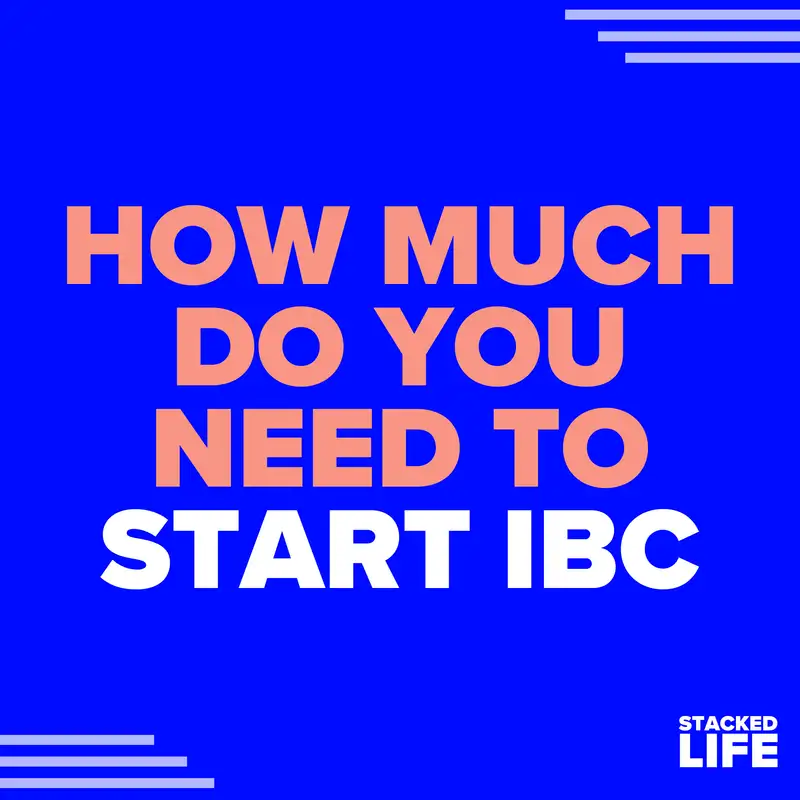10: How Much Do You Need to Start IBC?
How Much Do You Need to Start IBC?
Free Mini-Course:
StackedLife.com/Supercharge
StackedLife
Financial Strategies
Practical Limits
The first thing to do is remind ourselves about what type of asset whole life is.
Whole life is not an investment, it’s a cash equivalent asset. The reason this is important to refresh on is so that we can correctly compare it to other types of assets with regards to tax.
Practical Minimums& Maximums
Free Mini-Course:
StackedLife.com/Supercharge
StackedLife
Financial Strategies
How to calculate how much
Every insurance company will have min & max DBs
Practically speaking very broad.
From a premium perspective it’s like $100/mo min.
Maximums are harder to pin down but easily in the $500k/mo with the ability to go higher and even spread premiums across multiple carriers.
Underwriting limits are based on income or net worth. Easiest is income. More calculated methods are based on net worth for estate planning
Practically speaking, 25% of income. So if you make $100K, you could pay around $25K with no additional underwriting. I’ve helped clients go higher than 25% if it can be justified to underwriters by cash flow
“How Much Money Do You Want to Save?”
Free Mini-Course:
StackedLife.com/Supercharge
StackedLife
Financial Strategies
Emergency/Opportunity Fund
Outside of specific estate planning or other protection needs, for IBC, it’s pretty simple
Remember what we are doing – strategically capitalizing. Fancy name for “saving money”.
So the question I always ask is: How much money do you want to start saving in a strategic manner?
How much do you want to save in a place where you have control, grows tax-deferred
Cash Value forEmergencies &Opportunities
Free Mini-Course:
StackedLife.com/Supercharge
StackedLife
Financial Strategies
Be Careful About Cash Flow
Cash value can be looked at as your “Emergency / Opportunity” fund.
Dividend-paying whole life is cash-equivalent asset. So it’s a place to store cash. It’s perfect as an emergency fund – hopefull it never has to be used so it sits there. Where better than someplace where it’s earning more than a bank, tax-deferred, and also provides a death benefit, including accelerated DB that provide protection against chronic and terminal illness.
Anything over and above that becomes your opportunity fund. This is the place where cash goes first to then be leveraged to make your large purchases and investments, a la Infinite Banking.
Cash Flow Considerations
Free Mini-Course:
StackedLife.com/Supercharge
StackedLife
Financial Strategies
Don’t Play Games with Premium
As You think about premium amounts to pay as the amount you want to start saving strategically, here are some things I think everyone should be careful of.
The main thing is not to play games with policy design. I’ll explain that in just a minute after two seemingly obvious statements.
Don’t go too big. Even though there are several ways to pay premium without coming out of pocket, those ways become more viable as the policy matures. So you’re still making a commitment to pay premium for a long period of time. In one way, we want this commitment as a sort of “forced savings,” but we also don’t want to commit too much and get over our proverbial skis. I recommend committing to a premium you feel comfortable paying for the next 20, 30 years. Like I said, you don’t’ necessarily have to pay that long but that’s the mindset
Don’t go too small either! For most people, their income tends to rise over time. I’ve seen it happen where people tell me they wish they had started with more because they now have more income and now have to start a second policy
Ok here’s the thing I mentioned about playing games with policy design. The amount you want to save should be made up of both base and PUA…
Playing Games with Policy Design
Free Mini-Course:
StackedLife.com/Supercharge
StackedLife
Financial Strategies
The “Goldilocks” Rule
3. A lot of times people are coached into paying too much or too little in the form of playing games with base premium and PUA. This is not super technical but if you’ve never heard the terms base premium and PUA or Paid Up Additions, keep listening and you can go to stackedlife.com/premium to get the lay of the land.
Sometimes people will be coached into premium amounts that say whatever your comfort level is, that’s how much you should pay in base premium and then your “stretch”savings goal should be PUA. This can lead to people ending up with a premium that’s putting them into the affore mentioned getting over your skis. Base premium (which can sometimes include term rider premium) is always required to keep the policy inforce
Other times people hear about High Early Cash Value designs and think that the relatively small base premium and high PUA is ideal because it’s very low commitment. But this is just a form of paying too little, if you go back to Ep 8, you’ll remember that the main way to get high early cash value is to use short-pay policies. What ends up happening is that right as your policy starts to crank on all cylinders, you have to stop paying premium altogether or drop down to the small base premium amount in order to not MEC the policy. The only option if you want to continue strategically continue to capitalize is to start a new policy with all the new startup costs all over again - at your now older age – and that’s only if you still qualify at all.
So, again, playing games with premium components leads to paying too much or too little.
Balanced Approach
Free Mini-Course:
StackedLife.com/Supercharge
StackedLife
Financial Strategies
Finding More Money
Ok, so then how much should you pay?? I like to follow the Goldilocks Rule of Thumb.
This is not advice, but one thing I follow for my own policies to have a balance of base and PUA in my monthly or annually scheduled premium. This way, I have the flexibility to go down if needed and I have the flexibility to go up with additional PUA, over and above my scheduled amount.
So however much the amount of money you want to start saving strategically is, have that be your scheduled amount that you pay each month or year and have that scheduled amount have reasonably balanced amounts of base and PUA.
Remember, IBC is not a gimmick or hack and it requires long-range thinking. A more balanced approach ensures a balance between short term and long term
Going Bigger with no More Out-of-Pocket
Free Mini-Course:
StackedLife.com/Supercharge
StackedLife
Financial Strategies
Kickstarting Capitalization
A couple more thoughts on this subject:
What I just mentioned was identifying an amount that you want to start strategically saving that comes from your existing cash flow. What fairly often happens is money is discovered that’s kind of just getting away from people and they don’t even realize it. If this is happening, that means this money is not really in your control. By making simple shifts in cash flow, these dollars can be captured and used to pay higher premiums than expected, sort of kick starting your IBC journey, with no additional out-of pocket.
Kickstart with an Additional Lump Sum
Free Mini-Course:
StackedLife.com/Supercharge
StackedLife
Financial Strategies
Convertible Term Insurance
Another common thing that takes place is maybe someone already has some cash lying around for their emergency fund. If you have a balanced policy design, you can fold this emergency fund money into the policy, on top of the amount scheduled, right off the bat. This extra lump sum payment will all go to PUA and be over 90% accessible as cash value. This is an excellent way to kick start the performance of the design and start getting some higher order benefits from your emergency opportunity fund
Convertible Term Insurance
Free Mini-Course:
StackedLife.com/Supercharge
StackedLife
Financial Strategies
StackedLife.com
One final consideration if you’re wondering how much you need to get started – If you’re in the market for life insurance but you’re finding that your cash flow is insufficient or perhaps you have a large expense in the near future that might make committing to a larger premium difficult, consider some convertible term insurance.
StackedLife.com
Free Mini-Course:
StackedLife.com/Supercharge
StackedLife
Financial Strategies
As always…
Creators and Guests


